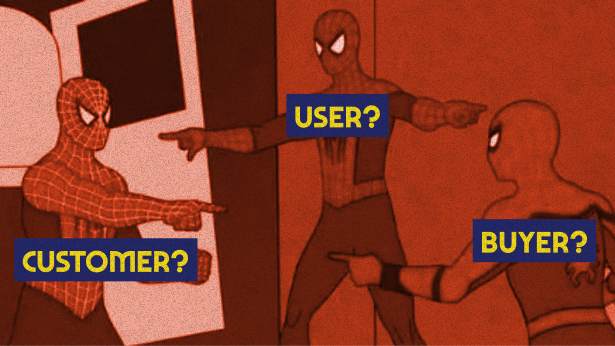The Difference Between User, Buyer, and Customer Explained

When designing a product, it can be confusing to know who your users, buyers and customers are.
To break it down for you...
The user is the person who uses your product to make progress. But they're not necessarily the ones paying for it.
The buyer is the person who makes the final decision to purchase your product and has a set of expectations as a result.
The customer is the entity that encapsulates both the user and the buyer, like a business.
Examples of User, Buyer and Customer
SaaS Product used by Twitter's finance team
- User - The finance team members
- Buyer - Chief Financial Officer
- Customer - Twitter
Salesforce used by XYZ Corp
- User - The sales/account executives
- Buyer - Chief Revenue Officer
- Customer - XYZ Corp
Dunder Mifflin Paper Company, Inc. uses Mailchimp
- User - The email marketing manager
- Buyer - Chief Marketing Officer
- Customer - Dunder Mifflin Paper Company, Inc.
In this context, the customer is much less important than the buyer and the user as they are actual people with needs.
Designing for the buyer category is not enough to ensure a product's success.
Many companies make the mistake of designing for the buyer when they should be designing for both the user and the buyer.
If a product isn't properly adopted by its users, the buyer's expectations will not be met, leading to cancellations.
Always aim to understand the goals and motivations of people from different categories if they aren't the same person.
How can you tell if a person is a user or a buyer?
The clue is in their designation. If they're higher in the company hierarchy, it commonly means they're buyers.
When it's less obvious, it's best to ask them questions such as:
- Why are they interested in the product?
- How do they intend to fit it into their lives?
- What problem does it solve for them?
- What's the end outcome that they're looking for?
- Is there anyone else who would like to weigh in before proceeding with the product? (users will point to buyers when asked this)
These will give you helpful answers to their motivation for using the product.
Buyers tend to answer with cost-benefit or time-saving statements to benefit the business.
Users commonly answer by describing how it will make their job or life easier when they use it.
By attempting to identify the different people involved in the product adoption process, you can narrow down your design and the decisions you need to make to best cater to their goals and motivations.
Remember these distinctions; you might find that your designs will be much better!
The Overlooked Persona: The Researcher
Many people focus on the user, buyer, and customer when designing a product. However, another essential persona often goes unnoticed: the researcher.
The researcher is the person who investigates and compares different products to find the best solution for their company's needs.
They may be users, buyers, or separate individuals. Despite their critical role in the product adoption process, researchers are often overlooked by product and marketing teams.
Why the Researcher Matters
Researchers are the gatekeepers of product adoption.
They are responsible for gathering information, evaluating options, and presenting their findings to decision-makers.
If a researcher doesn't find your product suitable or fails to understand its value, it's unlikely to be selected, regardless of how well it caters to users or buyers.
Designing for the Researcher
To ensure your product's success, it's crucial to design for the researcher's needs. This means:
- Providing comprehensive product information and resources
- Offering clear comparisons with competitors and highlighting differentiation points
- Sharing case studies and success stories from similar companies
- Presenting transparent pricing and ROI calculations
- Ensuring responsive and knowledgeable sales and support teams
By catering to the researcher's needs, you can increase the likelihood of your product being selected as one of the options considered.
Identifying the Researcher
Researchers can be difficult to identify, as they may not always be the ones directly interacting with your product. However, there are a few telltale signs:
- They ask detailed questions about product features, integrations, and comparisons with competitors
- They request case studies, whitepapers, or other in-depth resources
- They seek to understand the long-term value and ROI of the product
By keeping an eye out for these indicators, you can identify researchers and tailor your approach to meet their needs.
In summary, designing successful products requires understanding the distinct roles of users, buyers, customers, and researchers.
Each persona has unique goals and motivations that must be addressed to ensure product adoption and satisfaction.
By catering to the needs of all these key players, designers can create products that resonate, drive business success, and make a real difference.
Keep these distinctions in mind, and you'll be well-equipped to navigate the complex landscape of product design.
References
- Demand Side Sales - Bob Moesta (Check out my notes here).
